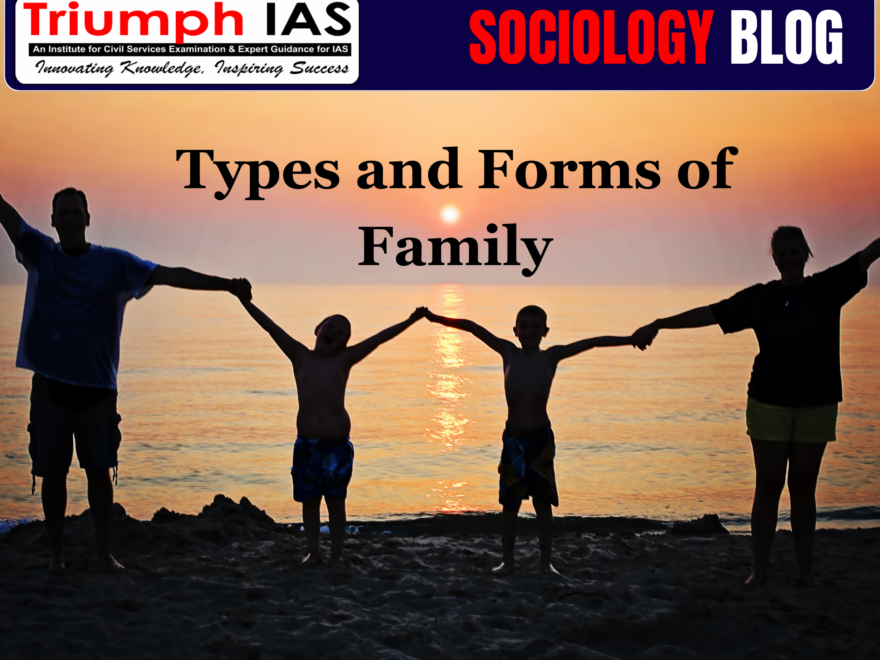|
The family has been seen as a universal social institution an inevitable part of human society. According to Burgess and Lock the family is a group of persons united by ties of marriage, blood or adoption constituting a single household interacting with each other in their respective social role of husband and wife, mother and father, brother and sister creating a common culture. G.P Murdock defines the family as a social group characterized by common residence, economic cooperation and reproduction. It includes adults of both sexes at least two of whom maintain a socially approved sexual relationship and one or more children own or adopted of the sexually co-habiting adults.
Nimkoff says that family is a more or less durable association of husband and wife with or without child or of a man or woman alone with children. According to Maclver family is a group defined by sex relationships sufficiently precise and enduring to provide for the procreation and upbringing of children. Kingsley Davis describes family as a group of persons whose relations to one another are based upon consanguinity and who are therefore kin to one another. Malinowski opined that the family is the institution within which the cultural traditions of a society is handed over to a newer generation. This indispensable function could not be filled unless the relations to parents and children were relations reciprocally of authority and respect. According to Talcott Parsons families are factories which produce human personalities.
Types and Forms
- On the basis of marriage: Family has been classified into three major types:
- Polygamous or polygynous family
- Polyandrous family
- Monogamous family
- On the basis of the nature of residence family can be classified into three main forms:
- Family of matrilocal residence
- Family of patrilocal residence
- Family of changing residence
- On the basis of ancestry or descent family can be classified into two main types:
- Matrilineal family
- Patrilineal family
- On the basis of size or structure and the depth of generations family can be classified into two main types:
- Nuclear or the single unit family
- Joint family
- On the basis of the nature of relations among the family members the family can be classified into two main types:
- The conjugal family which consists of adult members among there exists sex relationship.
- Consanguine family which consists of members among whom there exists blood relationship- brother and sister father and son etc.
Detail Analysis of Two Popular Type of Family Studied in Sociology:
Joint Family:
Social Aspect:
- Solidarity of Relationship: In joint families the solidarity of relationship is highly oriented towards blood relatives or siblings and not towards affinal relations, That is why such families are known as consanguineous family. All the household activities are done by daughter-in-laws because, they hardly have any importance in family. While describing the Indian joint family, S.C. Dubey says that, for any married woman her parents house use to be a sojourn place for her after marriage.
- Importance of Members: In joint family, the whole family is collectively important and not the particular members. Importance is mainly seen in the decision making process, which is widened from petty issues to very sensitive issues, that is why marriage related decisions are also taken at family level.
- Marriage Alliance : It is done at family level and not at individual level, that is why, it is said that marriage relationships are always established between two families. In such families, both husband and wife are related differently to different people and so they have very limited point of interaction between them and so, they hardly have any problem with each other. This issue was explained by Elizabeth Bott in her study of some families in Greater London and the same was supported by Rosser and Harris, which they described under “Degree of domesticity of women involved?
Political Aspect
- In the context of authority: In the patriarchal family the authority is in the hands of male and in matriarchal family, it is in the female hands. In every family, there is a head appointed, who is the representative of the whole family, so the decision taken by him is the cumulative or the collective decision of the family.
Economic Aspect :
- In the context of division of labour: Here, the division of labour is basically on the basis of age and sex. And so male used to work outside whereas females inside the wall of domesticity. There was no significance of talent & skill as for as work is concerned. The Feminist sociologist Ann Oakley has depicted in her study of British society that in pre- industrial Britain, the family was the basic unit of production. Where in, females were mostly assigned house work like cooking, cleaning, washing, child care and some other activities like dairy production activities. In other words they were engaged in some non essential activities, but the emergence of industrialization had changed their roles and now they have got the “dominant mature feminine role”.
- In the context of ownership of property : In joint family, the property is jointly owned, that is, it does not permit individual ownership.
Religious Aspect :
Religious activities in joint families are essential for everyone and are performed collectively. In this way, no member can have an individual stake in this particular field.
Cultural Aspects :
- In the context of functions : In joint families different kinds of functions used to take place, which one performs either in the obeisance of some rules or in the form of some Sankaras and the whole process is completed collectively.
- In the context of place of residence : The whole joint family, lives under one roof together and they have common kitchen as well.
Nuclear Family:
Social Aspect:
- Solidarity of Relations: The solidarity of relations are concentrated highly on of final relationship. In this way, blood relations are not that important. That is why, such families are called conjugal families However one more reason, corroborates the existence of such families that the ego has already got separated from its blood relatives.
- In this family, every member is important, that is why desire of any one member is not posed on others. i,e every member is free, independent and important at ones level. In marital decisions also, the significance of individual freedom is obvious i.e. the decision is taken by related persons only. In western industrial countries, there is absolute freedom for everyone. On this matter but in the countries like India, which are still traditionbased, where nuclear family structure in different from one found in western countries and that absolute freedom is not given in marital decisions.
Political Aspect:
In nuclear family, everyone has equal rights. In such families and in decision making matters, children are equally important. Such families are known as filiocentric families. The implementation of authorities is not done through compulsion, rather it is done through consensus i.e. the general consensus of the members, which is done through consultation.
Economic Aspect :
Division of labour is chiefly on the basis of ability and talent and not on the basis of age and gender. Owing to it, the conjugal roles are joint in nuclear families whereas, in joint families they were separated. This fact was elaborated and corroborated by Elizabeth Bott and Rosser & Harris. The property of the family is governed through modern rules and the property is achieved individually, then the concerned achiever would be the owner of that property.
Religious Aspect:
In the context of western countries and for nuclear families, S.C. Dubey has presented an analysis that with the advent & progress of science and technology people’s belief towards supernatural objects and powers diminished. In comparison to religion, they started getting their problems solved through science & technology, in a very rational way. This change let the people and the state adopt secular ideologies and now, at family level religious activities are no more essential, compulsory and obligatory for members.
Miscellaneous:
- Prominence of external agencies : MacIver has considered nuclear family as the unit of consumption. So whether, it is a matter of socialization of children, or of entertainment, external agencies are highly required because, the concerned commodities and services cannot be produced at family level. It is so because, wherever nuclear family exists, there is a prominence of specialization, that is, every member gets expertise in a particular field and for other services and commodities, he is bound to depend on others, this explanation was elaborately given by T. Parsons and William J. Goode in their studies of industrial societies.
- Improved status of women: With the increment of the elements of equality, freedom and right to decision making have altogether weakened patriarchy. Status of women is continuously getting improved. The economic freedom, among women is highly responsible for it. Ann Oakley has presented this kind of change in the women as ‘dominant, mature feminine role’.
- Increase in Individuality: It is just the opposite of Durkheim’s conception of collective consciousness because due to prevalence of tradition in collective consciousness, everyone thinks alike. And the same happens in the joint family of pre-industrial simple society. In modern nuclear families, individual consciousness prevails which leads the people towards economic prosperity. But, its dysfunction is seen in the form of anomie, which brings dissociation and separation in family- Apart from it, there is an increase in, crime, cyber crime, drug addiction, alcoholism prostitution, juvenile delinquency etc. There is one more important thing, which is seen in individuality and that is, people get complete privacy owing to the lack of familial and democratic pressures, which increases sexual freedom too. Conclusively, such families are becoming individualistic democrat.
Factors Responsible for the change in family structure in industrial society:
After scientific & industrial revolution, the patriarchal joint family, in western society started changing into
individualistic nuclear family. It was the need of the people to have this kind of family structure because it suited appropriately with the complete ecology. It has many important functions to impart and through it, many unimportant functions have been done away with it. Factors responsible for this kind of change are enormous but the most important and initiating factor has been industrialization. Overall the factors can be counted in the following way :
- Industrialization
- Modernization
- Secularization – Role of science & technology
Industrialization:
T. Parsons & William J. Goode have been important figures to describe the role of
industrialization in the emergence of nuclear families. Parsons argues that the isolated nuclear family is the typical family found in modern industrial society. It is structurally isolated, because it does not form an integral part of wider system of kinship relationship. T. Parsons says that a modern industrial system with a specialized division of labour demands considerable geographical mobility, from its labour force. Individuals with specialized skills are required to move to the places where those skills are in demand. The isolated nuclear family suits to the need of geographical mobility. It can be described in the following way:
- It doesn’t contain many kins in the structure and so wide range of obligation are shortened. So the obligation are focused more on a fewer people between husband-wife and child and they make a perfect bond between them.
- Parsons argues that the isolated nuclear family is the best form of family structure, for a society based on achieved status. Because, individuals are judged on the basis of status they have achieved.
- The pre-industrial society had a particularistic value system, so the system was that of ascribed one and because of this, conflict will tend to arise in this family unit larger than the isolated nuclear family, which will threaten the solidarity of the family. The isolated nuclear family largely prevents the problem from rising.
- In an isolated nuclear family, the family functions can be done in a better way like that of primary socialization of children, and stabilization of adult personality via expressive mother & wife.
- Supporting Parsons views – Ronald fletcher argues that not only has the family retain its functions but those functions have increased in detail and importance. Specialized institutions such as schools & hospitals have added to an improved family’s function, rather than superceded ones. Now parents are best guide to their children in there occupational and in their children healths. They are mentors in their achievement pattern.
- Parsons argues that family at macroscopic level has become almost completely functionless. But it does not mean that, the modern family has become, unimportant, rather its importance has increased. Now they are working for the integration and economic system of the larger society. And that way, it is playing its role in an appropriate way.
William J. Goode: Like Parsons, Goode argues that industrialization tends to undermine the extended family and larger kinship grouping. He explains the high rate of geographical mobility in industrial society, decreases the frequency and intimacy of contact among members of kin network. The relativity of high level of social mobility also tends to weaken kinship ties.
- For e.g. the upward mobility of a member of a working class family leads to adopt the lifestyle, attitude and values of his new social class. They would tend to cut him off from his working class kin. Many of the functions once performed by the family have been taken over by outside agencies such as schools, business and welfare organisations. This reduces the dependency of the individual on his family and his kin. The importance of achieved status in industrial society means that the family and kinship groups have less to offer to their members. Because of this reasons, people started having nuclear family and this suits to the new industrial society.
- Its effect was so important that even non industrial families, also took up this structure. Goode has found that in the industrial upper class family, a joint family structure is seen, but truly speaking, they are not joint mentally & emotionally. For this, Goode applies the concept of ‘role bargaining’ for such families. It means that the individual attempts to obtain the best possible bargaining on his relationship with others. He will attempt to maximise his gains. He maintains a good relationship with family members and submit to their control, if he feels, he is getting a good return on his investment of time, energy & emotions. With respect to the industrialization & extended family, Goode argues that it is not so much that new system is incompatible as it offers an alternative pattern of payments. But since lot of freedom & equality is involved in this family set up, eventually it functions like a nuclear family.
Modernization
- Role of Education: With the complete change in modern society, education system has also played a very important role. The modern education has led the people to give up superstitions and stubborn traditions to understand their rights and become highly awared. The attainment of specialization, in occupational differentiation is not possible in absence of modern education and it further shows that with the modern education, people are getting social mobility in their life.
- Pre-industrial society was divided into two classes-upper and lower, in which equal opportunity was not available universally. But now, in industrial societies this has been made possible, in which even the children of working class can attain a high social status.
- French sociologist, Raymond Boudon, in his positional theory, explains that a working class boy attains a high position and mobility in comparison to his father because he chooses the corresponding education course and in that way, by affecting his mobility, he affects his family structure, which can be seen in the form of nucleus family.
- Change in judiciary: Different types of Acts have been passed in due course of time, which has improved the status of women. Now, such women have become very much demanding, because they have realized their right of equality and freedom. The fulfillment of which can be done in nuclear family only. This has been elaborated, in the context of Indian family system by Ailleen Ross.
- Change in Political System: This offers equality and freedom to everyone. Goode believes that, owing to this right and freedom, the number of nuclear families, increased to a very high level, which have been seen in nonindustrial western societies. Kenneth Little supports this point, in his study of migration of rural kinship based society to urban industrial societies in West Africa – many migrants welcomed the freedom from obligation to their Kinsmen, which they experience in the towns.
- Change in ideology: Ann Oakley has presented a picture of British society as to how modernization has offered women modern roles. Now, they got a dominant mature feminine role. In pre-industrial Britain, the family was an important unit of production. People needed marriage & family in the form of their economic needs. Because all the members were involved in the production process. The role of women was important in both industrial and textile industry. But now the same family has become, the unit of consumption and awarded females are engaged in means of earning, which has increased the structure of nuclear family.
- Change in Mass Communication: This has raised the level of awareness and mobility to a large extent and has definitely affected family structure.
Secularization:
The demographic factors have become healthier, owing to which people adopted one or two child norm which automatically decreased the family size, which in turn has led to the structure of nuclear family in western societies. In Indian society also, people have adopted one or two child norm with the help of legal or illegal use of technology, which finally shape the family in the form of nuclear family.
The End of the Blog : Types and Forms of Family

|





















